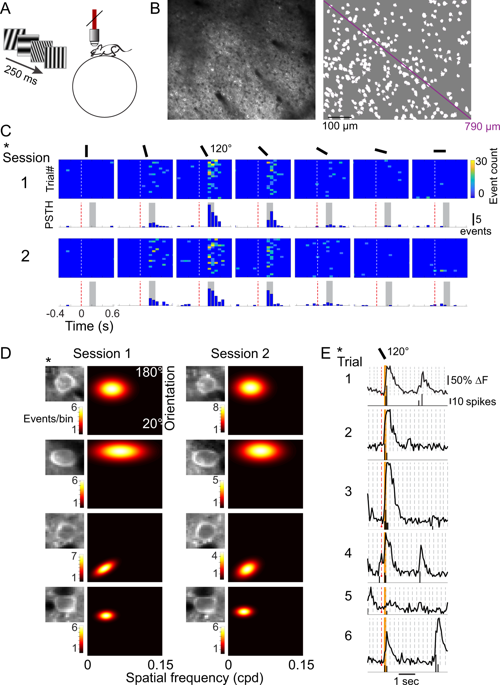Our official English website, www.x-mol.net, welcomes your
feedback! (Note: you will need to create a separate account there.)
Feature selectivity is stable in primary visual cortex across a range of spatial frequencies.
Scientific Reports ( IF 3.8 ) Pub Date : 2018-Oct-16 , DOI: 10.1038/s41598-018-33633-2 Brian B. Jeon , Alex D. Swain , Jeffrey T. Good , Steven M. Chase , Sandra J. Kuhlman
Scientific Reports ( IF 3.8 ) Pub Date : 2018-Oct-16 , DOI: 10.1038/s41598-018-33633-2 Brian B. Jeon , Alex D. Swain , Jeffrey T. Good , Steven M. Chase , Sandra J. Kuhlman

|
Reliable perception of environmental signals is a critical first step to generating appropriate responses and actions in awake behaving animals. The extent to which stimulus features are stably represented at the level of individual neurons is not well understood. To address this issue, we investigated the persistence of stimulus response tuning over the course of 1-2 weeks in the primary visual cortex of awake, adult mice. Using 2-photon calcium imaging, we directly compared tuning stability to two stimulus features (orientation and spatial frequency) within the same neurons, specifically in layer 2/3 excitatory neurons. The majority of neurons that were tracked and tuned on consecutive imaging sessions maintained stable orientation and spatial frequency preferences (83% and 76% of the population, respectively) over a 2-week period. Selectivity, measured as orientation and spatial frequency bandwidth, was also stable. Taking into account all 4 parameters, we found that the proportion of stable neurons was less than two thirds (57%). Thus, a substantial fraction of neurons (43%) were unstable in at least one parameter. Furthermore, we found that instability of orientation preference was not predictive of instability of spatial frequency preference within the same neurons. Population analysis revealed that noise correlation values were stable well beyond the estimated decline in monosynaptic connectivity (~250-300 microns). Our results demonstrate that orientation preference is stable across a range of spatial frequencies and that the tuning of distinct stimulus features can be independently maintained within a single neuron.
中文翻译:

在整个空间频率范围内,主视觉皮层中的特征选择性是稳定的。
可靠地感知环境信号是在清醒的行为动物中产生适当的响应和动作的关键的第一步。在各个神经元水平上稳定地表示刺激特征的程度尚不完全清楚。为了解决这个问题,我们调查了清醒成年小鼠初级视觉皮层在1-2周内刺激刺激调谐的持久性。使用2光子钙成像,我们直接将调谐稳定性与同一神经元内(尤其是第2/3层兴奋性神经元内)的两个刺激特征(方向和空间频率)进行了比较。在连续的成像过程中跟踪和调整的大多数神经元在两周内保持稳定的方向和空间频率偏好(分别占人口的83%和76%)。选择性 测得的方向和空间频率带宽也很稳定。考虑到所有这四个参数,我们发现稳定神经元的比例不到三分之二(57%)。因此,很大一部分神经元(43%)在至少一个参数上不稳定。此外,我们发现方向偏好的不稳定性不能预测相同神经元内空间频率偏好的不稳定性。人口分析显示,噪声相关值稳定在远远超出单突触连接性估计的下降幅度(约250-300微米)。我们的结果表明,取向偏好在一定范围的空间频率范围内是稳定的,并且可以在单个神经元内独立维持不同刺激特征的调整。也很稳定 考虑到所有这四个参数,我们发现稳定神经元的比例不到三分之二(57%)。因此,很大一部分神经元(43%)在至少一个参数上不稳定。此外,我们发现方向偏好的不稳定性不能预测相同神经元内空间频率偏好的不稳定性。人口分析显示,噪声相关值稳定在远远超出单突触连接性估计的下降幅度(约250-300微米)。我们的结果表明,取向偏好在一定范围的空间频率范围内是稳定的,并且可以在单个神经元内独立维持不同刺激特征的调整。也很稳定 考虑到所有四个参数,我们发现稳定神经元的比例不到三分之二(57%)。因此,很大一部分神经元(43%)在至少一个参数上不稳定。此外,我们发现方向偏好的不稳定性并不预示着同一神经元内空间频率偏好的不稳定性。人口分析显示,噪声相关值稳定在远远超出单突触连接性估计的下降幅度(约250-300微米)。我们的结果表明,取向偏好在一定范围的空间频率范围内是稳定的,并且可以在单个神经元内独立维持不同刺激特征的调整。因此,很大一部分神经元(43%)在至少一个参数上不稳定。此外,我们发现方向偏好的不稳定性不能预测相同神经元内空间频率偏好的不稳定性。人口分析显示,噪声相关值稳定在远远超出单突触连接性估计的下降幅度(约250-300微米)。我们的结果表明,取向偏好在一定范围的空间频率范围内是稳定的,并且可以在单个神经元内独立维持不同刺激特征的调整。因此,很大一部分神经元(43%)在至少一个参数上不稳定。此外,我们发现方向偏好的不稳定性不能预测相同神经元内空间频率偏好的不稳定性。人口分析显示,噪声相关值稳定在远远超出单突触连接性估计的下降幅度(约250-300微米)。我们的结果表明,取向偏好在一定范围的空间频率范围内是稳定的,并且可以在单个神经元内独立维持不同刺激特征的调整。人口分析显示,噪声相关值稳定在远远超出单突触连接性估计的下降幅度(约250-300微米)。我们的结果表明,取向偏好在一定范围的空间频率范围内是稳定的,并且可以在单个神经元内独立维持不同刺激特征的调整。人口分析显示,噪声相关值稳定在远远超出单突触连接性估计的下降幅度(约250-300微米)。我们的结果表明,取向偏好在一定范围的空间频率范围内是稳定的,并且可以在单个神经元内独立维持不同刺激特征的调整。
更新日期:2018-10-16
中文翻译:

在整个空间频率范围内,主视觉皮层中的特征选择性是稳定的。
可靠地感知环境信号是在清醒的行为动物中产生适当的响应和动作的关键的第一步。在各个神经元水平上稳定地表示刺激特征的程度尚不完全清楚。为了解决这个问题,我们调查了清醒成年小鼠初级视觉皮层在1-2周内刺激刺激调谐的持久性。使用2光子钙成像,我们直接将调谐稳定性与同一神经元内(尤其是第2/3层兴奋性神经元内)的两个刺激特征(方向和空间频率)进行了比较。在连续的成像过程中跟踪和调整的大多数神经元在两周内保持稳定的方向和空间频率偏好(分别占人口的83%和76%)。选择性 测得的方向和空间频率带宽也很稳定。考虑到所有这四个参数,我们发现稳定神经元的比例不到三分之二(57%)。因此,很大一部分神经元(43%)在至少一个参数上不稳定。此外,我们发现方向偏好的不稳定性不能预测相同神经元内空间频率偏好的不稳定性。人口分析显示,噪声相关值稳定在远远超出单突触连接性估计的下降幅度(约250-300微米)。我们的结果表明,取向偏好在一定范围的空间频率范围内是稳定的,并且可以在单个神经元内独立维持不同刺激特征的调整。也很稳定 考虑到所有这四个参数,我们发现稳定神经元的比例不到三分之二(57%)。因此,很大一部分神经元(43%)在至少一个参数上不稳定。此外,我们发现方向偏好的不稳定性不能预测相同神经元内空间频率偏好的不稳定性。人口分析显示,噪声相关值稳定在远远超出单突触连接性估计的下降幅度(约250-300微米)。我们的结果表明,取向偏好在一定范围的空间频率范围内是稳定的,并且可以在单个神经元内独立维持不同刺激特征的调整。也很稳定 考虑到所有四个参数,我们发现稳定神经元的比例不到三分之二(57%)。因此,很大一部分神经元(43%)在至少一个参数上不稳定。此外,我们发现方向偏好的不稳定性并不预示着同一神经元内空间频率偏好的不稳定性。人口分析显示,噪声相关值稳定在远远超出单突触连接性估计的下降幅度(约250-300微米)。我们的结果表明,取向偏好在一定范围的空间频率范围内是稳定的,并且可以在单个神经元内独立维持不同刺激特征的调整。因此,很大一部分神经元(43%)在至少一个参数上不稳定。此外,我们发现方向偏好的不稳定性不能预测相同神经元内空间频率偏好的不稳定性。人口分析显示,噪声相关值稳定在远远超出单突触连接性估计的下降幅度(约250-300微米)。我们的结果表明,取向偏好在一定范围的空间频率范围内是稳定的,并且可以在单个神经元内独立维持不同刺激特征的调整。因此,很大一部分神经元(43%)在至少一个参数上不稳定。此外,我们发现方向偏好的不稳定性不能预测相同神经元内空间频率偏好的不稳定性。人口分析显示,噪声相关值稳定在远远超出单突触连接性估计的下降幅度(约250-300微米)。我们的结果表明,取向偏好在一定范围的空间频率范围内是稳定的,并且可以在单个神经元内独立维持不同刺激特征的调整。人口分析显示,噪声相关值稳定在远远超出单突触连接性估计的下降幅度(约250-300微米)。我们的结果表明,取向偏好在一定范围的空间频率范围内是稳定的,并且可以在单个神经元内独立维持不同刺激特征的调整。人口分析显示,噪声相关值稳定在远远超出单突触连接性估计的下降幅度(约250-300微米)。我们的结果表明,取向偏好在一定范围的空间频率范围内是稳定的,并且可以在单个神经元内独立维持不同刺激特征的调整。











































 京公网安备 11010802027423号
京公网安备 11010802027423号